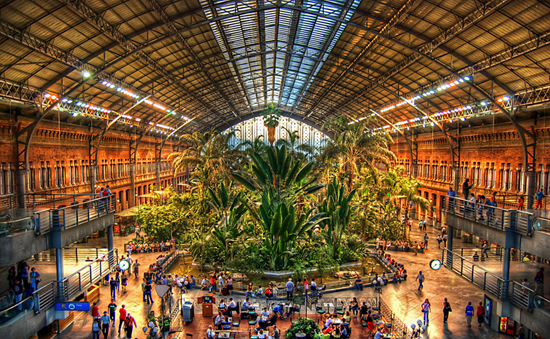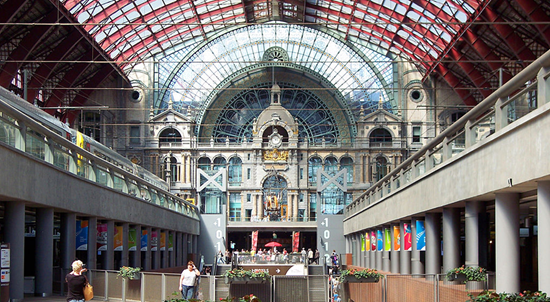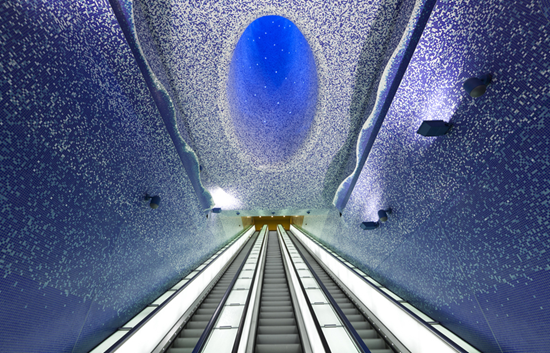
9 Train Stations With Unforgettable Architecture
By Josh Lew, Mother Nature Network, 2 November 2015.
By Josh Lew, Mother Nature Network, 2 November 2015.
Worth missing the train
Rail travel has come a long way over the years. Trundling locomotives have given way to high-speed rail with passenger cars furnished like the business-class section of an airliner.
But one aspect of train travel hasn't changed: the stations still provide some of the most interesting architecture in the world.
Even those who've never ridden on a train are familiar with New York City's Grand Central Station, and there are other railway hubs that are just as eye-catching, like the tropical garden of Atocha Station in Madrid [top image]. Some are modern creations, others have been faithfully renovated to preserve the past - but all of them are worth a look.
1. Kanazawa Station
Kanazawa Station is the rail hub in its namesake city in far western Japan. If you ever end up in this less-visited corner of the country, make sure to enter and exit through the eastern part of the station where there's a stunning piece of architecture called the Tsuzumi Gate (Tsuzumimon). The twisting wooden structure was designed to resemble a tsuzumi, which is a traditional Japanese drum.
Events are sometimes held under this eye-catching arch, where there's also a tourist information centre. This oft-photographed place is the most visually appealing part of this rail hub, but the design of the station itself is also eye-catching. The heavy use of glass gives Kanazawa an airy, greenhouse-like feel.
2. Antwerp Central Station
Antwerpen-Centraal (Antwerp Central) is the main rail station in its namesake Flemish city. Constructed over a 10-year period in the late 19th and early 20th centuries, the hub was originally the terminus of the rail line between Brussels and Antwerp. It has since been converted into a through station, but the original architecture remains almost completely intact.
Antwerp Central is widely considered one of the world's most beautiful stations on Earth. It was designed by famed Belgian architect Louis Delacenserie, who used a mixture of styles - from Neo-Renaissance to Art Nouveau - to create a building that's as impressive to architecture experts as it is to travellers. Passengers go through the palatial main hall on the way to catch their train to Amsterdam or Brussels.
3. Atocha Station
Atocha Station in the heart of Madrid dates back to 1851. Today, it mainly serves commuter trains and regional trains coming to and from Barcelona, Sevilla, Valencia and other Spanish cities. There are also Madrid Metro stops connected to the station, which has been renovated over the years. The "old" station still stands, but it's used as a concourse that people pass through on the way to the new station.
The old station has a vaulted ceiling and lots of glass that lets in natural light. The most noticeable feature is a huge tropical garden that stretches for more than 43,000 square feet right down the middle of the concourse. Seating areas, cafes and shops are spread along the sides of this greenhouse-like building.
4. Chhatrapati Shivaji Terminus
Chhatrapati Shivaji Terminus is one of the world's best remaining examples of Victorian Gothic Revival architecture. Located in the heart of Mumbai, this station is one of the busiest in India with 18 constantly buzzing platforms (seven for local and commuter trains and 11 for long-distance trains). Shivaji is the hub for the Central Railway Zone, the busiest of India's 16 train zones.
This station was originally named Victoria Terminus, after the queen of the British Empire at the time. It was renamed in 1996 in honour of Chhatrapati Shivaji, the first ruler of the Maratha Empire, which controlled large parts of India prior to British imperial rule.
5. Berlin Hauptbahnhof
Berlin Hauptbahnhof (Berlin Main Station) is relatively young. While the sweeping glass structure officially opened in 2006, the history of the site where it was built dates back to 1870, when it was known as Lehrte Station. After being damaged in World War II, Lehrte saw limited use and was demolished after falling under East German jurisdiction.
Plans for a new station began soon after reunification. The most noticeable characteristic of the Hauptbahnhof is its curved glass roof, which is almost 400 feet long. The open design allows in a lot of natural light while also protecting waiting passengers from the elements.
6. Union Station
Washington, D.C.'s Union Station is one of the busiest Amtrak stations in the country. More than 5 million people pass through its halls each year. In the past, the station's statistics have been even more impressive. During World War II, as many as 200,000 people used Union's platforms in a single day.
The original station was renovated recently. It's now mainly used for retail, though many of the people who pass through are train passengers. Like many other buildings in Washington, D.C., Union Station's design was inspired by the architecture of ancient Rome.
7. St. Pancras International
Even if you weren't aware of what you were seeing, you've probably come across pictures of London's St. Pancras Station, now officially known as St. Pancras International. It's widely considered one of the best examples of Victorian architecture in London. It was renovated in the early '00s to the tune of almost £800 million (roughly US$1.2 billion).
After renovations, the station was able to accommodate the high-speed Eurostar trains that connect England with the continent. Pancras is also a major domestic hub for rail service from other parts of England.
8. Chicago Union Station
Chicago is one of the few places in the Midwest where trains still rule. Local commuters get around on elevated trains - the famous "L" - and on the Metra system. The city's main rail hub, Union Station, first opened during the Roaring '20s. The Beaux Arts design and towering columns make this building one of Chicago's trademark structures. The marble floors and brass fixtures give the interior an atmosphere that inspires the imagination.
The main tenants are Amtrak and Metra, Chicagoland's commuter rail service. Most of Amtrak's long-distance trains make a stop at Union Station. People who champion rail travel will be encouraged by Union Station's future plans. The station is working on a plan to accommodate a significantly higher number of passengers over the next two decades.
9. Toledo Station, Naples
Photo: Oscar Tusquets Blanca
Naples is home to a subway system with a creative flair. Some of the rail stops, known as Metro Art Stations, have extensive art installations. Toledo Station, which serves the popular Via Roma shopping street, is one of the most spectacular.
The station features ornate mosaics and a work by visual artist Robert Wilson. Dubbed Light Panels, Wilson's installation brings brightness to the lowest part of the station, where an escalator drops passengers more than 50 meters below street level.









No comments:
Post a Comment
Please adhere to proper blog etiquette when posting your comments. This blog owner will exercise his absolution discretion in allowing or rejecting any comments that are deemed seditious, defamatory, libelous, racist, vulgar, insulting, and other remarks that exhibit similar characteristics. If you insist on using anonymous comments, please write your name or other IDs at the end of your message.